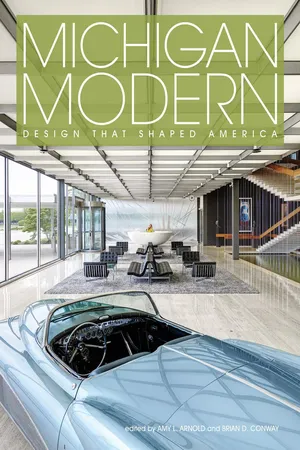![]()
Introduction
Michigan’s Role in the Development of Modernism
Amy L. Arnold
Michigan Modern Project Manager, Michigan State Historic Preservation Office
Brian D. Conway
State Historic Preservation Officer, Michigan State Historic Preservation Office
Michigan made everyday life modern. Its educational institutions trained generations of talented architects and designers. The furniture industry transformed homes and offices. Industrial designers styled the cars that came to represent the American dream. Michigan architects defined an era.
The synergy of industry, prosperity, and educational leadership in Michigan produced and attracted some of the most important Modern architects and designers of the twentieth century. Albert Kahn, Harley Earl, Eliel and Eero Saarinen, George Nelson, Alexander Girard, Ray and Charles Eames, Florence Schust Knoll, and Minoru Yamasaki are just a few of the internationally recognized designers that made Michigan a global influence. These visionaries touched nearly every aspect of American life and left an unparalleled legacy by combining art with mass production to put Modern design in every household. A midcentury powerhouse of Modern design, Michigan’s vibrant design industry continues to thrive today.
Michigan’s role in the development of Modernism follows three intersecting tracks—industry, architecture, and education—and can be broken into three major time periods: the early foundation of Modern design (1900–39), war production and new technology (1940–45), and the postwar boom (1946–70). The time line of Michigan’s global influence is bracketed by the early-twentieth-century industrial work of Albert Kahn and the post–World War II architecture of Eero Saarinen and Minoru Yamasaki that defined the 1950s and 1960s. In between is a continuum of outstanding designers, architects, buildings, and products, many of which have become Modern icons.
The Foundation of Modern Design (1900–39)
Ford, Kahn, and Industrial Architecture
Michigan is well known as the home of Henry Ford, the industrialist who introduced assembly-line production to automobile manufacturing. By creating the first affordable automobile, Ford transformed society, not only in America but worldwide. However, the impact of the assembly line on the evolution of architecture is a much less familiar story. It set in motion two developments that became a foundation for Modern architecture. First, the factories architect Albert Kahn designed for Henry Ford were the inspiration for the International style, which by the 1930s came to be synonymous with Modernism. Second, Ford’s mass-production techniques stimulated interest in the use of modular components and standardization in building materials by architects wanting to create quality, affordable housing.
Though Albert Kahn began designing industrial buildings around 1901, it was his 1905 commission with the Packard Motor Car Company of Detroit that changed the face of Modern architecture. Building #10 of the Packard complex was Kahn’s first experiment with the use of reinforced concrete, a relatively new building material at that time. Kahn’s brother Julius had studied engineering at the University of Michigan and created a new and effective concrete reinforcement system, which he patented as the “Kahn Bar System.” When Henry Ford hired Albert Kahn to design the Highland Park Ford Plant (1908) to accommodate the first automobile assembly line, Kahn realized that standard nineteenth-century timber and masonry construction simply could not handle the volume and scale required for the new process. Instead he chose to use his brother’s Kahn Bar System, which enabled the design of large concrete floor plates supported by concrete columns resulting in vast open interiors. Albert Kahn was also the first to introduce industrial steel sash windows, which originated in England, to American construction. The wide expanses of glass brought large amounts of daylight into the production area.[1] This revolutionized modern factory design worldwide.
When designing industrial buildings, Kahn focused on the properties of the new materials he was using and on the building’s function, not on decoration or ornamentation. The simplicity and structural honesty of Kahn’s reinforced-concrete factory designs had not been seen before. His work became an inspiration for architects around the world who were looking for a “modern” approach to design; most notably, European architects Le Corbusier, Walter Gropius, and Ludwig Mies van der Rohe. Kahn later experimented with structural steel beam construction, and his design of the Glass Plant (1922) at the Ford River Rouge Complex is considered a milestone in modern industrial architecture. The pureness of its form, with massive glass skin and expressive V-shaped roofline, results directly from the functional need to allow the heat from the glass production process to escape.
Albert and Julius Kahn, along with younger brothers Felix, Gustave, Louis, and Moritz, developed a prefabricated building components system based on the Kahn Bar System that was marketed through a company they established, the Trussed Concrete Steel Company (Truscon). When a Truscon building withstood the 1906 San Francisco earthquake while all the surrounding buildings failed, it brought increased interest in the Kahns’ products. According to the book Exporting American Architecture, 1870–2000, “By 1907 the Kahn system had been used not only in over 1500 U.S. and 90 U.K. structures, but also on a broader global scale. . . . [It] became the pre-eminent system exported by Americans between the World Wars.”[2] Truscon’s 1907 catalog listed offices in London, Havana, and Canton, China.[3] In 1910, Julius Kahn traveled to Japan to establish a Truscon office there. Frank Lloyd Wright used the Kahn Bar System in the construction of the Imperial Hotel in Tokyo, which opened in 1923 and survived the Kanto earthquake later that same year.[4] Truscon was headquartered in Detroit, and by 1920 had opened a steelworks in Youngstown, Ohio, and had franchises on every continent. The Kahn brothers continued to search for ways to standardize and simplify construction techniques and systems. Truscon applied for a patent for an open truss steel joist in 1925. Initially meant to provide a fireproof floo...




